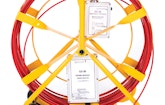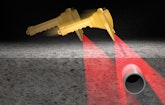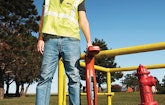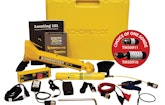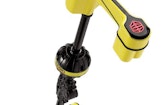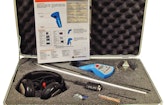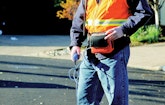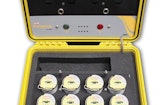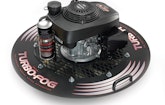Interested in Location/Detection?
Get Location/Detection articles, news and videos right in your inbox! Sign up now.
Location/Detection + Get AlertsLimiting sewer line inflow and infiltration requires a dedicated maintenance program and tools that can assess pipe condition and note areas of concern. Cameras, smokers and locators might be ways to identify leaks, but are these tools every utility should have in its toolbox?
Yes and no, says Duane Johnson, vice president at Affordable Pipeline Services in San Diego and a former CCTV inspection operator and flow monitoring field technician.
“What it really comes down to is agency size,” he says. A smaller utility with limited staff might be better off outsourcing its leak detecting, whereas a larger utility with a 20-member dedicated sewer department might find it more economical to budget $150,000 for a camera system and $200,000 a year for staffing.
So, just as a carpenter wouldn’t use a hammer to turn a screw, what goes into your utility toolbox depends on the task at hand. For some, that might be a camera, locator and smoker system.
“It’s not one toolbox fits everybody,” Johnson says. Here are some tools to consider when identifying leaks:
1. Inspection systems
“A smaller agency would probably want a push camera, where they can immediately go out and look at something,” Johnson says. “You’re talking $50,000 to $70,000 for a small tractor system that can be used on the majority of lines.” Inspection systems include self-leveling cameras, pan n’ tilt push units and scanners:
- The MY400 municipal inspection system from MyTana Mfg. Company is designed for small to medium municipalities that operate, document and maintain sanitary sewer systems. The system includes a self-leveling color camera with 36 Super Brite LEDs and a built-in 512 Hz transmitter. The DCB12 control system incorporates a touch screen with drop-and-drag icons to easily identify common problems. The laptop-based system allows for easy recording, uploading and backup of inspection activities. The unit includes 400 feet of pushrod and an AccuStic 512 Hz locator/receiver, which pinpoints problems before digging the sewer line. The Super Sonde is also included, providing a stronger signal for locating deeper problems in the lines. Different system configurations and related accessories are available.
- The Pan n’ Tilt push camera from Ratech Electronics is a portable inspection system for pipes and drains as small as 3 inches in diameter. Camera options include black and white, color, self-leveling, micro and pan n’ tilt. The camera can be retrofitted to existing Ratech systems or used as a stand-alone unit. It rotates 330 degrees up/down and 220 degrees left/right, allowing users to view the pipe condition in detail. Combining the camera with a Ratech control unit such as the Elite SD gives recording capability using SD/USB drives and allows MPEG video capture and JPEG image capture. Also included is an on-screen display overlay system providing electronic distance counter, time, date and eight pages of memory for listing problems and displaying company information. Standard 200-foot gel-rod cable is included. Longer lengths are available.
- The ES-38 sewer lateral inspection unit from Electro Scan automatically identifies and quantifies cracks, joints and connection defects using technology to measure the variation of electrical current inside pipes.
2. Locators
A locator is another piece of equipment utilities should have in their everyday toolbox. If a homeowner calls with a problem; you want to be able to verify the problem immediately, Johnson says. “Your crew can go out with a push camera for $15,000 that would include a locator; it’s kind of your immediate tool.”
Although most location work is done on residential sewer lines or commercial tie-ins, locators can be useful when it comes to finding a lateral connection, buried manholes or a sewer line that trails off into a remote area.
“At that point you would use a sonde that goes onto a robotic camera system that will allow you to see above ground where it’s going,” he says. Locators can be used to identify plastic and metal pipe, as well as other infrastructure:
- The All Materials Locator (AML) from SubSurface Instruments Inc. (SSI) locates metallic and nonmetallic pipes and cables using ultra-high microwave frequencies to find subsurface objects. The unit can locate plastic, metal, wood, cable and pipe. It functions in clay, wet soil, snow or standing water without the need for a separate transmitter and receiver, wires, clips or clamps. The lightweight locator is designed for the utility, water, gas and cable industries.
- The 830 R/T (receiver/transmitter) locating system from Ditch Witch is designed to provide best performance at a high active frequency. The high-frequency locator can trace poor conductors, such as underground tracer wire, and locate short lengths of utility infrastructure. The unit has a variety of automatic features, including gain control, auto depth and visual and audio feedback. The system has an IP65 environment rating, and a battery life of 150 hours on the transmitter and 75 hours on the receiver. Adaptive filtering ensures that the unit is highly responsive in all modes of operation, providing left-to-right guidance quickly regardless of mode or operator style. In PV (peak verify) mode, the system gives operators an additional way to verify location.
- The PCS-800 pipe/cable and sonde locating kit from Schonstedt Instrument Company includes a portable, belt-holstered pipe and cable locator, 512 Hz sonde and accessories. The locator can detect buried metallic pipes or cables by direct connect or inductive means. Either of two 512 Hz sondes enable crews to pinpoint pipe blockages or areas in need of repair. Used with an inspection camera or drain cleaning machine, the sonde can be traced above ground with the receiver.
- The SeekTech SR-20 utility line locator from RIDGID features OmniSeek technology and uses a combination of multi-directional antennas, mapping display and processing to locate underground utilities. The high-resolution LCD is equipped with an automatic backlight function for low-light situations and displays line depth, current and field angle in real time. It also has a volume-adjustable function to let users know if they are on target. In addition to tracing transmitted frequencies, the device uses passive modes to locate undocumented metallic lines.
- The HL10 hand-held acoustic water leak locator from Vivax-Metrotech is easy-to-use and compact with acoustic and visible values for leak survey and leak pinpointing. The unit has high-quality acoustic properties that enable it to locate tiny leaks. With three filter settings, the device can be adjusted to the individual task and to suppress interfering background noise. The visual LED indicator assists the leak location procedure. A built-in LED light allows for work in low-light areas. Users gain versatility when combining the unit with the GM80 wind-protected ground microphone.
- The LD-18 digital leak detector from SubSurface Leak Detection reduces ambient, intermittent noises such as barking dogs, passing cars, footsteps and people talking, instantly suppressing them. The unit can identify continuous leak sounds in difficult situations such as busy streets. Headphones are not needed to locate pipe leaks directly under asphalt or ground.
- The Enigma from ADS Environmental Services is a digital correlation logging system used to locate leaks in buried water pipes. It combines noise logging and correlation into one operation. Units are available with three or eight optically programmed recording pods and feature three user-defined start time and recording intervals. Pods are placed on listening locations and collected after recording intervals expire. Sound files are downloaded and transferred to the PC-based correlating software. Thumbnail results are color-coded in decreasing confidence (red, yellow, blue). Each thumbnail can be clicked on for complete full-screen correlation information and advanced filtering. Results can be overlaid on Google Maps for ease of location. Pods can be reprogrammed and redeployed within minutes for the next 27 correlations. Loggers include built-in, magnetically coupled accelerometers. Hydrophones are also available for plastic pipe.
3. Smokers
If inflow is a problem, a utility might consider a smoker to identify the source. “I’ve seen a couple small agencies go out and get smoke testing equipment, and it’s extremely useful, especially in areas where you’ve got more rainfall,” Johnson says. “As the cost of treatment goes up, the last thing you want to do is treat rainwater as sewage, and a smoker is a pretty cheap way of identifying that.”
Here are some smoke testing tools to consider:
- The Air-Loc smoke tester from Cherne Industries is available as a liquid smoke blower or a traditional smoke bomb smoke blower, allowing accurate detection of inflow, infiltration and cross connections. Made of aluminum casting, the lightweight tester makes transportation easy. The tester also includes a poly fan blade that has high volume capabilities and can generate up to 3,769 cubic feet of airflow per minute. The unit is available with a Honda or Briggs & Stratton engine. Each engine has an easy-to-start vertical pull recoil starter.
- The self-contained Turbo-Fog MH-75 manhole smoke blower uses leakproof liquid smoke cartridges to create dense, white smoke. Made of 11-gauge steel with a powder-coat finish, the blower generates over 7,500 cfm. No additional smoke bombs or garden sprayers are necessary. The unit is available with a Briggs & Stratton or Honda engine.
- The Model 20 smoke blower from Superior Signal Company is designed for smoke testing of sewer lines to detect sources of inflow and other faults. Used with the company’s classic smoke candles, the unit provides visible smoke that finds faults at a long distance. The Superior 3C classic smoke candle produces a volume of 40,000 cubic feet of smoke in three minutes, with the option of joining W3C smoke candles to create larger volumes of smoke for a longer time, when two or more candles are linked together. The blower can be configured with the company’s smoke fluid system to offer a liquid-based alternative for mainline sewer inspection, featuring an insulated heating chamber with stainless steel injector to maximize dry smoke output, and produce high-quality liquid-based smoke.
(All equipment listings from MSW Product Focus, November 2012.)

